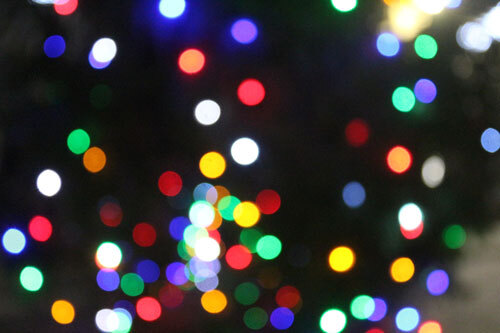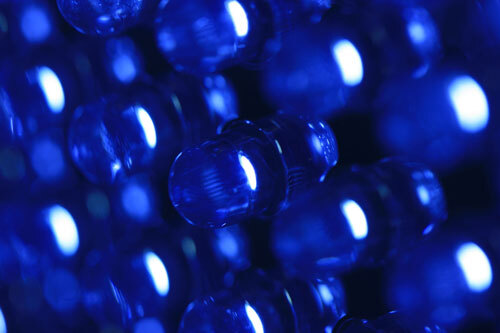
(Teigan Rodger/Flickr)
Why these tiny little lights feel so harsh to your eyes
A little over four years ago, the American Medical Association felt compelled to publicly raise concerns with a growing trend on many highways—the replacement of older lighting systems with new ones that used LED lighting.
The reason? The new lights were often too harsh.
“High-intensity LED lighting designs emit a large amount of blue light that appears white to the naked eye and create worse nighttime glare than conventional lighting,” the association warned. “Discomfort and disability from intense, blue-rich LED lighting can decrease visual acuity and safety, resulting in concerns and creating a road hazard.”
But why blue light in particular? What about it makes it so awful on your eyes? And does the problem scale down?
This is a question, of course, that scientists have been researching for decades … without realizing it. In 1958, researchers J. Woodland Hastings (an expert in photobiology) and Beatrice M. Sweeney (a plant physiologist) published a paper, “Characteristics of the diurnal rhythm of luminescence in Gonyaulax polyedra,” that analyzed the impact of different colors of light on the Gonyaulax polyedra, a kind of dinoflagellate (a single-celled organism) with the ability to emit light.
This early paper, which actually predates the visible LED by a few years, noted that the organism reacted differently to varying colors of light, with its strongest reaction to the color blue, and perhaps a lesser one to the color red. It affected their circadian rhythm, or their sleep-wake cycle. It was an interesting piece of research, but it didn’t gain major significance in the broader scientific community until decades later, after both scientists had passed.
In a 2010 article for the academic journal Environmental Health Perspectives, author David C. Holzman noted the reason for that—it turns out that what affects single-cell organisms also affects humans:
Hastings and Sweeney’s paper, published in the December 1958 Biological Bulletin, gathered dust for decades. No one thought these findings might hold any relevance for humans, whose circadian rhythms were then widely believed to be relatively insensitive to light.
But scientific discoveries in the past two decades have changed all that. Not only does light reset the human circadian rhythm, but the same blue light that has the strongest impact on dinoflagellates has equal power to reset our own clocks—although most visible wavelengths can reset the clock, the blues do the job with the greatest efficiency.
And blue light, a key part of what makes light visible and vibrant, is everywhere, especially in screens and other artificial light sources. It’s widely considered the reason why you might struggle to go to bed if you’ve been looking at your laptop or smartphone beforehand.
This, of course, is not new information and if you’ve read any pop-science content on the internet in the past decade, you’ve most assuredly heard about how blue light is bad for you and harms your sleep cycle.

(automotocycle/Flickr)
But this explanation gets to the heart of the problem we face with individual LEDs that flash in our faces at all hours of the day. Blue LEDs, which again tend to be the brightest, were actually the hardest to generate. The complication was such that, when three Japanese researchers—Shuji Nakamura, Isamu Akasaki, and Hiroshi Amano—did figure it out, it eventually earned them a Nobel Prize for physics.
(Side note: Nick Holonyak Jr. was notably salty about not getting a Nobel Prize when the inventors of the blue LED did.)
The invention of the blue LED is at the center of the what gives us white LED light, which has revolutionized the lighting industry—but which some consider harsh, which means it can have the same problems as blue light. (Hence the AMA messaging against using it for street lights.)
But even before then, people were noticing the harshness of blue LEDs in electronics such as routers and computer monitors. As Ian Johnson wrote for The Globe and Mail in 2004, before the concerns about blue light really went mainstream:
Blue LEDs have a piercing clarity that draws the eye immediately, and which can mesmerize. They shimmer, they twinkle, and they can be incredibly intense for such tiny points of light—they’re really quite beautiful.
The problem is they’re suddenly everywhere.
They adorn my monitor, handheld scanner, webcam, a USB hub, a Bluetooth access point, a WiFi adapter, a desktop volume control for my speakers, an external hard drive, a video editing peripheral (that one actually pulses), and the docking cradle for a rechargeable mouse. There are six more on the front of my new computer.
And they do pierce. My wireless router, for example, uses blue lights to let me know about network traffic patterns, and they are harsh to the point of distraction, despite being behind a thick layer of plastic. Yet they’re somehow less distracting than the white light on the nearby TV set, which is produced by combining blue LEDs with other colors, and significantly larger than it needs to be. (On the plus side, I learned recently that this annoying light, which is not particularly necessary, can be turned off. I just turned it off. Thank the Lord.)
But even before everything went blue, it wasn’t like red LEDs—the basis of many alarm clocks and old Hayes modems—or green LEDs were any better. They tend to distract in large part because of a lack of subtlety. They make their appearance known, even as their glow is inherently focused and tightly wound.
At 2 a.m. in the morning, a small LED indicator can be enough to thrust you from sleep mode, to pull you out of a normal circadian rhythm. And it can be quite distracting.